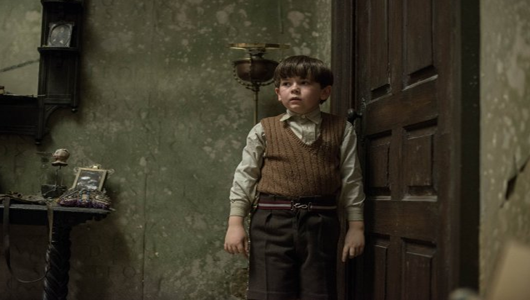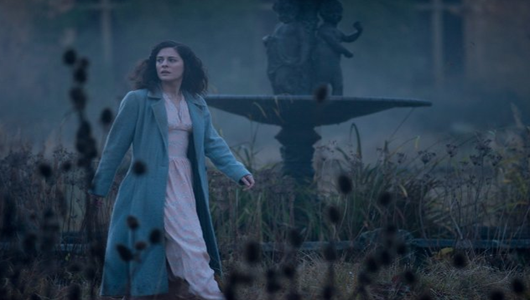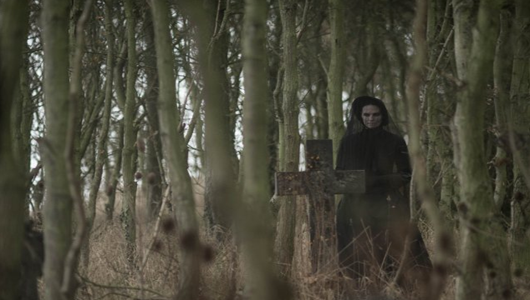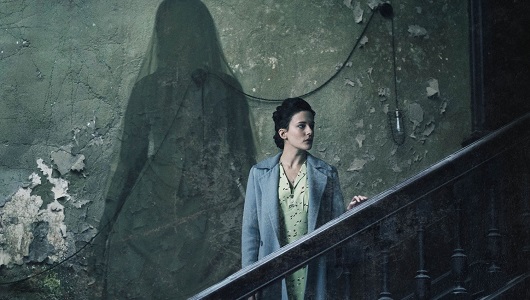The Woman in Black so appealing. Well, it certainly provided a draw, along with the film’s restrained eeriness and sophisticated tension building. There was also the star power of Daniel Radcliffe in his first leading cinematic role since the end of Harry Potter. Whatever is was, it worked and the film went on the become the most successful British horror film since records began. Unsurprisingly, we are now faced with a sequel trying to recapture the same creepy magic.
[box type="info"]
• Director: Tom Harper
• Exhibition: 2D
• Rating: 15
• Run Time: 98 Mins
[/box]
 The Story of the Woman in Black has gone through many incarnations, beginning life as a novel released in the 1980s consciously written in the style of a traditional Victorian ghost story. It found further life as a very well received TV movie, and it also formed a part of London’s theatrical history, with its stage adaptation currently holding the title of the second-longest running play in the West-End. But for all this longevity, the question of whether it has the potential to work as a fully-fledged horror franchise is still to be answered.
The Story of the Woman in Black has gone through many incarnations, beginning life as a novel released in the 1980s consciously written in the style of a traditional Victorian ghost story. It found further life as a very well received TV movie, and it also formed a part of London’s theatrical history, with its stage adaptation currently holding the title of the second-longest running play in the West-End. But for all this longevity, the question of whether it has the potential to work as a fully-fledged horror franchise is still to be answered.
 The return is set 40 years after Arthur Kipps’ (Radcliffe) fateful trip to the enigmatic Eel Marsh House, in the now-deserted town of Crythin Gifford. This is the home of the Woman in Black (Best), whose traumatic loss of her son drives her to post-mortem vengeance on those unlucky enough to come face to face with her. The rule of thumb is that whenever she is spotted, a child will die in horrific circumstances shortly thereafter. So obviously, this is the perfect setting for the relocation of a group of evacuee children escaping wartime time London, accompanied by school teacher Eve Parkins (Fox) and stern Headmistress Jean Hogg (McCrory). Despite being a touch too young for the role, Radcliffe’s endearing anguish is definitely missed. While Fox makes for a likeable lead, she doesn’t quite win the same sympathies, and her anaemic romance with Pilot Harry Burnstow (Irvine) feels contrived and pointless. And while feelings of isolation are increased as a result of the towns-people finally seeing sense and relocating en masse, we miss the backdrop of a whole community living in constant fear which served to emphasise the ghostly inhabitant’s power. The blitz instead provides a traumatic context, with each lead character carrying a war-induced suffering. Much like the death of Kipp’s wife in the original instalment, this provides points of weakness to be exploited throughout the course of the narrative.
The return is set 40 years after Arthur Kipps’ (Radcliffe) fateful trip to the enigmatic Eel Marsh House, in the now-deserted town of Crythin Gifford. This is the home of the Woman in Black (Best), whose traumatic loss of her son drives her to post-mortem vengeance on those unlucky enough to come face to face with her. The rule of thumb is that whenever she is spotted, a child will die in horrific circumstances shortly thereafter. So obviously, this is the perfect setting for the relocation of a group of evacuee children escaping wartime time London, accompanied by school teacher Eve Parkins (Fox) and stern Headmistress Jean Hogg (McCrory). Despite being a touch too young for the role, Radcliffe’s endearing anguish is definitely missed. While Fox makes for a likeable lead, she doesn’t quite win the same sympathies, and her anaemic romance with Pilot Harry Burnstow (Irvine) feels contrived and pointless. And while feelings of isolation are increased as a result of the towns-people finally seeing sense and relocating en masse, we miss the backdrop of a whole community living in constant fear which served to emphasise the ghostly inhabitant’s power. The blitz instead provides a traumatic context, with each lead character carrying a war-induced suffering. Much like the death of Kipp’s wife in the original instalment, this provides points of weakness to be exploited throughout the course of the narrative.
 While the first film was all about patient, slow-burn creepiness, with teasing glimpses of something lurking in the shadows being enough to create an uneasy atmosphere, its sequel unfortunately decides to forgo this formula. What we are given instead is far less accomplished and finely tuned; it’s not slow burn, for the first hour it’s simply dull. For all the classily stark and controlled visuals, most of the scares come in the form of cheap jump-shocks at regular intervals, which lower the tone from aspiring classic to knocked-together B-Movie. They may give you a fright on your first watch, but soon grow tedious and predictable. The spectre herself has also received a bit of a stylistic makeover. Not content to simply skulk on the periphery anymore she’s taken to crawling about ceilings in a fashion more reminiscent of a J-horror ghoul than an austere Victorian era ghost. And the rule of ‘the monster is only scary when dealt with from a distance’ again proves true, because as soon as she starts getting up-close and personal she’s far less frightening.
While the first film was all about patient, slow-burn creepiness, with teasing glimpses of something lurking in the shadows being enough to create an uneasy atmosphere, its sequel unfortunately decides to forgo this formula. What we are given instead is far less accomplished and finely tuned; it’s not slow burn, for the first hour it’s simply dull. For all the classily stark and controlled visuals, most of the scares come in the form of cheap jump-shocks at regular intervals, which lower the tone from aspiring classic to knocked-together B-Movie. They may give you a fright on your first watch, but soon grow tedious and predictable. The spectre herself has also received a bit of a stylistic makeover. Not content to simply skulk on the periphery anymore she’s taken to crawling about ceilings in a fashion more reminiscent of a J-horror ghoul than an austere Victorian era ghost. And the rule of ‘the monster is only scary when dealt with from a distance’ again proves true, because as soon as she starts getting up-close and personal she’s far less frightening.
 Over-familiarity begins to creep in as another issue that hampers the story. Having had the story of Jennet’s decent into madness following the loss of custody of her son skilfully revealed to us in the previous film through slow tantalising exposition, to have to endure a new set of characters going through the same discoveries obviously doesn’t have the same mystery and intrigue.
However, one familiar element that does work is the setting, and this is the star of the film. Both Eel Marsh House and the surrounding barrenly beautiful landscapes are given the prideful treatment they deserve, with the lonely foggy marshes and oppressive warped walls of the house providing the film with most of its character and atmosphere.
[box type="tick"]Elegantly eerie visuals[/box]
[box type="alert"]Relies too heavily on jump-scares[/box]
[box type="alert"]Less polished than its predecessor[/box]
For all its ambition to recapture the creepy, restrained chills of its predecessor, Angel of Death misses the mark and fails to deliver the same quality of expertly crafted scares, choosing cop-out jumps instead which leave the bits in between notably dreary. While Harper certainly knows how to make a film look the part, with its elegantly bleak and often disturbingly surreal aesthetic being one of few highlights, this film is sadly a case of style over substance. Its aimlessness and lack of truly frightening moments betray its rushed money-driven motive, an unfortunate misfire for a story that has become ingrained in British horror tradition.
[youtube id=”G4rzV0CvhyM”]
[box type="info"]The author paid to see The Woman in Black: Angel of Death[/box]
[ilink url="http://www.hammerfilms.com/ourwork/77/the-woman-in-black-angel-of-death"]Official Movie Site[/ilink]]]>
Over-familiarity begins to creep in as another issue that hampers the story. Having had the story of Jennet’s decent into madness following the loss of custody of her son skilfully revealed to us in the previous film through slow tantalising exposition, to have to endure a new set of characters going through the same discoveries obviously doesn’t have the same mystery and intrigue.
However, one familiar element that does work is the setting, and this is the star of the film. Both Eel Marsh House and the surrounding barrenly beautiful landscapes are given the prideful treatment they deserve, with the lonely foggy marshes and oppressive warped walls of the house providing the film with most of its character and atmosphere.
[box type="tick"]Elegantly eerie visuals[/box]
[box type="alert"]Relies too heavily on jump-scares[/box]
[box type="alert"]Less polished than its predecessor[/box]
For all its ambition to recapture the creepy, restrained chills of its predecessor, Angel of Death misses the mark and fails to deliver the same quality of expertly crafted scares, choosing cop-out jumps instead which leave the bits in between notably dreary. While Harper certainly knows how to make a film look the part, with its elegantly bleak and often disturbingly surreal aesthetic being one of few highlights, this film is sadly a case of style over substance. Its aimlessness and lack of truly frightening moments betray its rushed money-driven motive, an unfortunate misfire for a story that has become ingrained in British horror tradition.
[youtube id=”G4rzV0CvhyM”]
[box type="info"]The author paid to see The Woman in Black: Angel of Death[/box]
[ilink url="http://www.hammerfilms.com/ourwork/77/the-woman-in-black-angel-of-death"]Official Movie Site[/ilink]]]>
Review: The Woman in Black: Angel of Death

